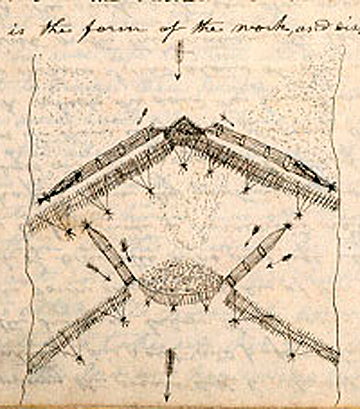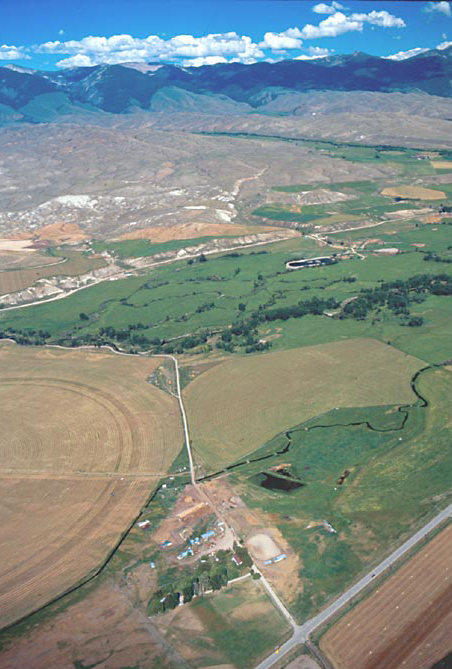Meriwether Lewis was still at Camp Fortunate on 21 August 1805, preparing to lead the main party with all of the company baggage over what he still hoped would be a relatively short portage to a navigable branch of the Columbia. Clark was 60 miles away, on an extended reconaissance to learn whether American know-how and determination could overcome the riverine obstacles Chief Cameahwait had described to Lewis.
On that sub-freezing morning[1]It was cold enough that morning to freeze the ink in Lewis’s pen—19 degrees above zero at sunrise. That’s typical of the “August anomaly,” which is a prominent feature of … Continue reading Clark visited a Lemhi Shoshone camp on the west bank of the Lemhi River near today’s Salmon City, where he and his men were fed on “Sammon boiled, and dried Choke Cher[rie]s,” and taken on a sight-seeing trip to the nearby permanent fishing weirs. Clark’s own journal for the 21st contains only a brief description of the Shoshones’ method of gigging fish, but nothing about the fish weir. It was not until the 30th, when the corps was back together again, that Lewis inserted in his own journal for the 21st a transcript of Clark’s observations:
This view looks east-northeast (75° TN) at the general location of the Shoshones’ fishing weirs on the Lemhi River. The Lemhi meets the Salmon River at Salmon City, which is just out of the photo above right center.
The many old channels of the river can be easily distinguished in this photo. Although there has been much changing and filling in of the channels for agricultural purposes, it is still obvious that the river was divided into several separate courses in this broad, flat stretch of the valley. The fish weirs reported in the journals were located slightly up river from the pond in the upper right quadrant of the photo, although the weirs probably stretched all along this section, where there were so many good sites in the various channels. The old trail came right through the ranch house area at the bottom of the photo. All of this area is now privately owned.
—Steve Russell, April 2004.
he found the wear extended across four channels of the river which was here divided by three small islands. three of these channels were narrow, and were stoped by means of trees fallen across, supported by which stakes of willow were driven down sufficiently near each other to prevent the salmon from passing. about the center of each a cilindric basket of eighteen or 20 feet in length terminating in a conic shape at it’s lower extremity, formed of willows, was opposed to a small apperture in the wear with it’s mouth up stream to receive the fish.
the main channel of the water was conducted to this basket, which was so narrow at it’s lower extremity that the fish when once in could not turn itself about, and were taken out by untying the small ends of the longitudinal willows, which frormed the hull of the basket. the wear in the main channel was somewhat differently contrived. ; there were two distinct wears formed of poles and willow sticks, quite across the river, at no great distance form each other. each of these, were furnished with two baskets; the one wear to take them ascending and the other in decending.
in constructing these wears, poles were first tyed together in parcels of three near the smaller extremity; these were set on end, and spread in a triangular form at the base, in which manner, that two of the three poles ranged in the direction of the intended work, and the third down the stream. two ranges of horizontal poles were next lashed with willow bark and wythes to the ranging poles, and on these willow sticks were placed perpendicularly, reaching from the bottom of the river to about 3 or four feet above it’s surface; and placed so near each other, as not to permit the passage of the fish, and even so thick in some parts, as with the help of gravel and stone to give a direction to the water which they wished.– the baskets were the same in form of the others.
this is the form of the work, and disposition of the baskets.
Notes
| ↑1 | It was cold enough that morning to freeze the ink in Lewis’s pen—19 degrees above zero at sunrise. That’s typical of the “August anomaly,” which is a prominent feature of meteorological annals in the Northern latitudes. By 4:00 P.M. the temperature was 78 above. |
|---|
Experience the Lewis and Clark Trail
The Lewis and Clark Trail Experience—our sister site at lewisandclark.travel—connects the world to people and places on the Lewis and Clark Trail.
Discover More
- The Lewis and Clark Expedition: Day by Day by Gary E. Moulton (University of Nebraska Press, 2018). The story in prose, 14 May 1804–23 September 1806.
- The Lewis and Clark Journals: An American Epic of Discovery (abridged) by Gary E. Moulton (University of Nebraska Press, 2003). Selected journal excerpts, 14 May 1804–23 September 1806.
- The Lewis and Clark Journals. by Gary E. Moulton (University of Nebraska Press, 1983–2001). The complete story in 13 volumes.



